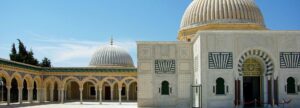Tunisia's center for pottery and traditional handicrafts
The city is one of the most important handicraft centers in the country and was already known in ancient times as Neapolis for its pottery. The settlement directly on the sea was a powerful Carthaginian city with a port in Punic times, from which a road led across the peninsula to the capital. It was made in the 5th century BC. Briefly occupied by Agathocles from Syracuse, destroyed by the Arabs in the 8th century and re-established later inland. While strolling through the alleys you can see how mats are woven from Halfagras, the famous hand-painted tiles come from here and in the ceramic workshops both painted, glazed vessels and unglazed, openwork pottery are made, which are particularly suitable as lanterns .
The Dar Chaabane district is known for its stonemasons who create columns, capitals and other decorations from the white sand-lime brick found in the nearby mountains. The men sit on the floor until late in the evening and carve traditional patterns into the soft stone.






